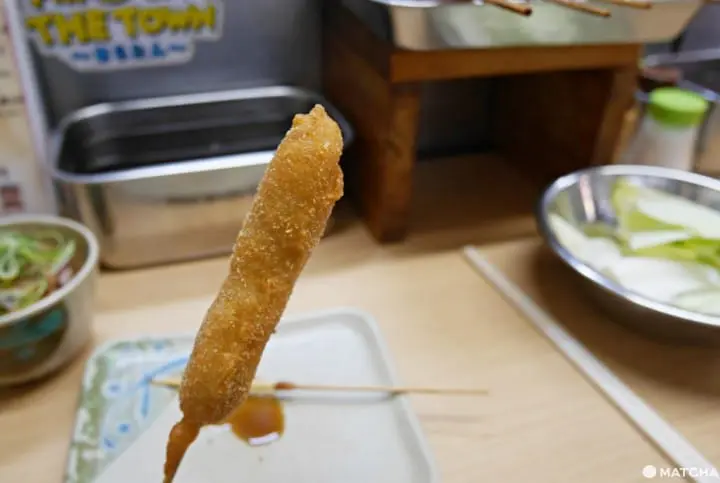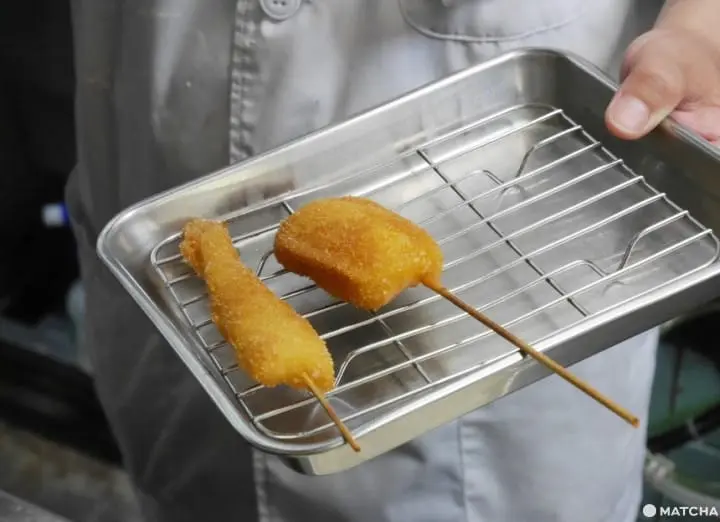Kushikatsu Daruma: Sample Japanese Soul Food in Osaka

Kushikatsu skewers are an Osaka favorite as famous as takoyaki and okonomiyaki. This cuisine started in a shop called Kushikatsu Daruma in the Shinsekai district. Read on to find out the former owner's inspiration to create this dish and why double-dipping in the sauce is a no-no!
Osaka's Kushikatsu: Soul Food of the Common People
Kushikatsu, an Osaka specialty, is as popular as world-famous Japanese dishes like takoyaki and okonomiyaki. Beloved by everyday people, it originated some 90 years ago in a shop in Osaka's Shinsekai (Tsutenkaku) district.
The original kushikatsu also came with a rule: skewers can only be dipped in the sauce once!
In today's article, we'll introduce the background story of what inspired this unique Osaka favorite.
A Beloved Dish Born in the Shinsekai District

The first kushikatsu was made in 1929. At the time, there were many day laborers in Osaka's Shinsekai district. Despite working hard every day, their wages were not high.
A local woman thought to herself, "I'd like to make some food that's reasonably priced, but also satisfying and filling for them." She decided to cut ingredients into bite sized pieces before deep-frying them on skewers. The dish soon became a big hit.
Kushikatsu Daruma: Where the Skewers All Started

Kushikatsu Daruma, the woman's shop, became well-known as the birthplace of kushikatsu. These deep-fried skewers with their delightful crispy texture would soon become one of Osaka's signature soul food dishes.

In the beginning, Kushikatsu Daruma was just a food stall. Today, the Kushikatsu Daruma Shinsekai Flagship Store has inspired a small chain of stores.
With a floor space measuring 107 square feet and just 12 counter seats, the flagship store is quite cozy, and retains the atmosphere from its early days. The food's original flavor has been faithfully passed down through the years!
No Double-Dipping Allowed!

When you step inside Kushikatsu Daruma Shinsekai Flagship Store, you'll see containers of dipping sauce on the tables.
But please be cautioned. Customers are allowed to dip their kushikatsu skewer into the sauce just once! And only skewers that haven't been tasted yet.

One of the reasons why double-dipping is prohibited is sanitation. However, this isn't the whole story.
Kushikatsu was initially made to fill up laborers on a budget.
In those days, customers used just enough sauce for their own needs. As a result, no sauce would go to waste and the owner would be able to keep costs down. This led to the thrifty dipping rule.

Since you only get one chance to dip your skewer, make sure to soak up lots of sauce!
When a customer leaves the shop, staff will remove leftover breading from the sauce container so that it's clean for the next visitor.
Which Menu Items Does the Owner Recommend?
When you arrive at the shop where these delicious skewers originated, you'll want to try a variety of kushikatsu. In fact, at Kushikatsu Daruma Shinsekai Flagship Store, they offer 38 different varieties!
Fortunately, the shop manager, Mr. Hirano, gave us his personal recommendations.
Tomato

Tomato: One skewer costs 105 yen (before tax)
Mr. Hirano's top recommendation is the tomato kushikatsu.
The special house batter coats the mini tomato, so you'll bite into the juiciness that immediately spreads inside your mouth. The tomato is perfectly cooked and incredibly sweet. It truly is a simple yet superb deep-fried skewer.
The Original Ganso Kushikatsu

Ganso Kushikatsu: One skewer costs 105 yen (before tax)
The Ganso Kushikatsu is a classic recipe from the shop's early days. This beef skewer is served fresh and piping hot. The crunchy outer coating pairs well with the sweet and salty sauce.
Our writer was deeply moved by the thought that this food has comforted the stomachs and souls of hard working laborers for nearly 100 years.
Doteyaki

Doteyaki: 350 yen (before tax)
The shop also has one menu item that's not deep-fried. Doteyaki is a dish made with konjac (yam jelly) and beef tendon, slowly simmered in miso.
The soft and tender beef tendon soaks up the miso flavor, making this a thick and hearty dish, while the konjac adds a satisfying texture.
The Flagship Store Set

The Flagship Store Set: 1,400 yen (before tax) *The set above is for photo purposes only. The skewer selection may differ.
If you're not sure what to order, go with the Flagship Store Set, exclusive to its namesake store. In addition to the Ganso Kushikatsu and Doteyaki, this nine-skewer set includes seafood and vegetables.
This writer's favorite was the simple and tasty asparagus skewer!
Offset the Oil With Some Fresh Cabbage

At Kushikatsu Daruma Shinsekai, customers receive free refills on cabbage. Fresh cabbage cuts through the oily kushikatsu, letting you to enjoy plenty of deep-fried skewers.
You're also allowed to dip pieces of cabbage into the sauce. But remember that the "no double-dipping" rule still applies (Try using a fresh piece of cabbage to scoop out some sauce to drizzle over your fried skewers)!

While visiting the shop, our writer saw a customer enjoying the fresh cabbage; from the many skewers left behind, it's easy to see just how delicious kushikatsu truly is!
From Family-Run Business to Chain Store

Kushikatsu Daruma started as a family-run business, but when there wasn't a third-generation successor, they considered closing their shop.
However, with the suggestion of a regular customer, the baton was passed to the present-day owner.
Since then, chain stores have opened and continue to flourish. Kushikatsu has grown in popularity to be considered one of Osaka's top three dishes.

Outside Kushikatsu Daruma is a statue of a tough-looking man, reminding everyone that double dipping is strictly forbidden! It was apparently modeled after the present owner.
Help Yourself to Some Freshly Made Kushikatsu!

These bite-sized kushikatsu skewers are piping hot with Osaka spirit. If you'd like to experience this warmth firsthand, pay a visit to Kushikatsu Daruma!
Read also
*This article was originally published in traditional Chinese on July 3, 2019. It was then translated into English from the Japanese article translation.



































![[2026] Top 5 Strawberry Picking Spots in Tokushima, Naruto| Farms and Access Guide for January to May](https://resources.matcha-jp.com/resize/720x2000/2025/03/06-227165.webp)


